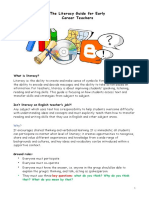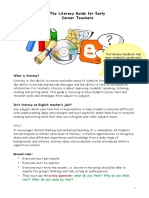Concept Maps: Why Use A Concept Map?
Concept Maps: Why Use A Concept Map?
Uploaded by
astien26Copyright:
Available Formats
Concept Maps: Why Use A Concept Map?
Concept Maps: Why Use A Concept Map?
Uploaded by
astien26Original Description:
Original Title
Copyright
Available Formats
Share this document
Did you find this document useful?
Is this content inappropriate?
Copyright:
Available Formats
Concept Maps: Why Use A Concept Map?
Concept Maps: Why Use A Concept Map?
Uploaded by
astien26Copyright:
Available Formats
Concept Maps
A concept map is a visual organizer that can enrich students' understanding of a
new concept. Using a graphic organizer, students think about the concept in several ways. Most
concept map organizers engage students in answering questions such as, "What is it? What is it
like? What are some examples?" Concept maps deepen understanding and comprehension.
When to use: Before reading During reading After reading
How to use: Individually With small groups Whole class setting
More comprehension strategies
Directed Reading Thinking Activity (DRTA)
Jigsaw
Listen-Read-Discuss (LRD)
Why use a concept map?
It helps children organize new information.
It helps students to make meaningful connections between the main idea and other
information.
They're easy to construct and can be used within any content area.
How to use a concept map
Note: It is important that teachers spend time introducing younger students to charts and
diagrams prior to using this strategy.
There are several ways to construct concept maps. Most include the following steps:
1. Model how to identify the major ideas or concepts presented in a selection of text as you
read.
2. Organize the ideas into categories. Remind students that your organization may change as
you continue to read and add more information.
3. Use lines or arrows on the map to represent how ideas are connected to one another, a
particular category, and/or the main concept. Limit the amount of information on the map
to avoid frustration.
4. After students have finished the map, encourage them to share and reflect on how they
each made the connections between concepts.
5. Encourage students to use the concept map to summarize what was read.
Download blank templates
Template 1 (280K PDF)*
Template 2 (52K PDF)*
Template 3 (56K PDF)*
Examples
Science
How a concept map could be used with a topic such as the study of weather.
See example >
Here's a more complex concept map from a study on bats.
See example > (40K PDF)*
How concept maps have been used in early childhood education to help students understand
more about trees, their bodies, and other familiar topics.
See example >
Here's a step-by-step on building concept maps for a variety of topics: plants, football, and the
Cinderella fairytale.
See example >
Differentiated instruction
For second language learners, students of varying reading skill, students with
learning disabilities, and younger learners
Teachers can use concept maps as a pre-reading strategy by inviting students to share
what they already know about a particular concept. While reading, teachers should ask
students to help add to the map as a group using an overhead or large chart. This provides
a visual aid for building upon their prior knowledge with new information they have
gathered from reading.
Teachers may wish to have students practice writing skills by asking students to write on
their own concept map.
Teach vocabulary words explicitly and use simple words.
Be sure the pointed part of each arrow is clear. Design the graphics to minimize
directional confusion.
When applicable, allow students to draw pictures or use cut out pictures as well as words.
You might also like
- EdTPA PlanningDocument6 pagesEdTPA Planninglauraemily171% (7)
- Corrigé Du 26 AvrilDocument11 pagesCorrigé Du 26 AvrilQuentin BellenfantNo ratings yet
- Minds Eye Lesson PlanDocument1 pageMinds Eye Lesson Planapi-376097525No ratings yet
- Java Machine TestDocument3 pagesJava Machine TestMuthyala Akhil100% (2)
- Accelerated Learning Practice Mind MappingDocument3 pagesAccelerated Learning Practice Mind MappingsoloiosochisonoNo ratings yet
- Concept MapsDocument2 pagesConcept Mapsapi-374307299No ratings yet
- Teaching and Learning With Graphic OrganizersDocument8 pagesTeaching and Learning With Graphic OrganizersPeter BobilesNo ratings yet
- Sketching My Way Through Text Strategy GuideDocument2 pagesSketching My Way Through Text Strategy Guideapi-340726722No ratings yet
- Do's and Don'Ts of Demo-TeachingDocument5 pagesDo's and Don'Ts of Demo-TeachingRegin PaildenNo ratings yet
- Standard 10 ArtifactDocument6 pagesStandard 10 Artifactapi-224128717No ratings yet
- Setting of BookDocument11 pagesSetting of BookGracie O. ChingNo ratings yet
- Reading StratDocument4 pagesReading Stratmary graceNo ratings yet
- Module 7 Elt 222Document24 pagesModule 7 Elt 222Feliculo JaponaNo ratings yet
- Graphic OrganisersDocument43 pagesGraphic OrganisersJince JosephNo ratings yet
- Graphic OrganizersDocument3 pagesGraphic OrganizersnamavayaNo ratings yet
- Edma3200 Lesson5practicumDocument3 pagesEdma3200 Lesson5practicumapi-252533855No ratings yet
- Angels Basic Productivity ToolsDocument2 pagesAngels Basic Productivity Toolsapi-688135233No ratings yet
- Activating Prior Knowledge and Reflective ToolsDocument4 pagesActivating Prior Knowledge and Reflective ToolsMaria Sabbah GhandourNo ratings yet
- Using Graphic OrganizersDocument9 pagesUsing Graphic OrganizersRonalyn LumanogNo ratings yet
- Teaching Vocabulary Using The Mind Map Technique Is A Highly Effective Way To Help Students Visually Organize and Retain New WordsDocument2 pagesTeaching Vocabulary Using The Mind Map Technique Is A Highly Effective Way To Help Students Visually Organize and Retain New WordsngocthuchoaninhNo ratings yet
- How To Teach Reading ComprehensionDocument5 pagesHow To Teach Reading ComprehensionReyaaz KarjiekerNo ratings yet
- The Ultimate List of Graphic Organizers For Teachers and StudentsDocument1 pageThe Ultimate List of Graphic Organizers For Teachers and StudentsPrince Marc Cabelleza DanielNo ratings yet
- Literacy HandbookDocument16 pagesLiteracy Handbookapi-299191866No ratings yet
- Strategy Notebook Explanation2Document20 pagesStrategy Notebook Explanation2api-396110984No ratings yet
- Collaborative Strategic ReadingDocument5 pagesCollaborative Strategic ReadingFebry Daulays100% (1)
- Week 3 Prof. Aldo Rodríguez Learning StrategiesDocument31 pagesWeek 3 Prof. Aldo Rodríguez Learning StrategiesGiuli PanizzoloNo ratings yet
- Literacy HandbookDocument16 pagesLiteracy Handbookapi-299191866No ratings yet
- Strategy CatalogueDocument5 pagesStrategy Catalogueapi-288560316No ratings yet
- Classroom Modeling - PhippsDocument8 pagesClassroom Modeling - Phippsapi-399906068No ratings yet
- Mind MapDocument13 pagesMind MapValarmathi100% (1)
- Strategies For Improving Reading Comprehension SkillsDocument5 pagesStrategies For Improving Reading Comprehension SkillsSusarla SuryaNo ratings yet
- Ronie Biñas Teaching Strategies Activity 12Document7 pagesRonie Biñas Teaching Strategies Activity 12Anthony JimenezNo ratings yet
- Teaching StrategiesDocument34 pagesTeaching Strategiesalfredyanga08No ratings yet
- Graphic Organizers Concept MapsDocument6 pagesGraphic Organizers Concept MapsPrincess Marquez TayongtongNo ratings yet
- BrainstormingDocument11 pagesBrainstormingSuzette MiagaNo ratings yet
- Thinking Maps-Tools For Learning PDFDocument12 pagesThinking Maps-Tools For Learning PDFYap Wooi LingNo ratings yet
- Graphic OrganizersDocument13 pagesGraphic Organizersm44006277No ratings yet
- The Ultimate List of Graphic Organizers For Teachers and StudentsDocument22 pagesThe Ultimate List of Graphic Organizers For Teachers and StudentsCharles Kenn MantillaNo ratings yet
- Discussion Graphic Organizers & NotetakingDocument4 pagesDiscussion Graphic Organizers & Notetakingandrew irunguNo ratings yet
- STAGE 1: Desired Results: Lesson Plan TemplateDocument5 pagesSTAGE 1: Desired Results: Lesson Plan Templateapi-385983469No ratings yet
- DokumenDocument4 pagesDokumenNovita MarpaungNo ratings yet
- Examples:: A. Concept Mapping: The Organization of Science Concepts What Is A Concept Map?Document3 pagesExamples:: A. Concept Mapping: The Organization of Science Concepts What Is A Concept Map?Flexi PanesNo ratings yet
- StagesDocument4 pagesStagesMIRELLA TORRES FERNANDEZNo ratings yet
- How Do You Effectively Engage Your Students in LearningDocument22 pagesHow Do You Effectively Engage Your Students in LearningKim B. AlcanceNo ratings yet
- Teaching Strategies in Social ScienceDocument4 pagesTeaching Strategies in Social ScienceKaren Calderon FloresNo ratings yet
- What Are Graphic OrganizersDocument15 pagesWhat Are Graphic Organizerssani biNo ratings yet
- ScaffoldingDocument4 pagesScaffoldingWaluyo Janwar PutraNo ratings yet
- Using Mind Maps To Develop Writing: EachingenglishDocument3 pagesUsing Mind Maps To Develop Writing: EachingenglishMohammed Jai Sujiya KhanNo ratings yet
- Collaborative Strategic ReadingDocument6 pagesCollaborative Strategic ReadingUmi AntariNo ratings yet
- Constructivist Lesson PlanDocument8 pagesConstructivist Lesson Planapi-495365721100% (1)
- Ten Ideas For Small Group Work in The R.E. Classroom BookletDocument8 pagesTen Ideas For Small Group Work in The R.E. Classroom BookletAmeyRuled AriffinNo ratings yet
- Inquiry (5E) Lesson Plan Template: For TeachersDocument5 pagesInquiry (5E) Lesson Plan Template: For Teachersapi-487905844No ratings yet
- General EducationDocument3 pagesGeneral EducationPaulo Tiangson MejiaNo ratings yet
- Carlyle Lessonplantemplate-Iste-2022Document6 pagesCarlyle Lessonplantemplate-Iste-2022api-651833621No ratings yet
- Media, 32275, enDocument6 pagesMedia, 32275, enAnish JohnNo ratings yet
- BPT Lesson IdeaDocument5 pagesBPT Lesson Ideaapi-554061413No ratings yet
- Teaching Strategies For Students With Disabilities: Knowing Is A Process Not A Product"Document10 pagesTeaching Strategies For Students With Disabilities: Knowing Is A Process Not A Product"api-277933265No ratings yet
- Concept MappingDocument10 pagesConcept MappingJonica LancionNo ratings yet
- Teaching Writing and Reading Skill Through Mind MapDocument5 pagesTeaching Writing and Reading Skill Through Mind MapNoir Screamer Sii BoundjourNo ratings yet
- Elementary Lesson Plan Edtpa 4Document5 pagesElementary Lesson Plan Edtpa 4api-510467425No ratings yet
- Millicent Atkins School of Education: Common Lesson Plan TemplateDocument8 pagesMillicent Atkins School of Education: Common Lesson Plan Templateapi-346719524No ratings yet
- Informational Text Toolkit: Research-based Strategies for the Common Core StandardsFrom EverandInformational Text Toolkit: Research-based Strategies for the Common Core StandardsNo ratings yet
- Degree of ComparisonDocument4 pagesDegree of Comparisonastien26No ratings yet
- Soal Adjective ClauseDocument4 pagesSoal Adjective Clauseastien26100% (2)
- Soal Latihan PronounDocument6 pagesSoal Latihan PronounNifa HanifahNo ratings yet
- Bhs Inggris Kls XiDocument7 pagesBhs Inggris Kls Xiastien26No ratings yet
- Soal Un 1617Document12 pagesSoal Un 1617astien26100% (1)
- Contoh Teks Storry TellingDocument4 pagesContoh Teks Storry Tellingastien26No ratings yet
- Capter 9Document4 pagesCapter 9astien26No ratings yet
- Listening Section 2Document2 pagesListening Section 2astien26No ratings yet
- Asking and Giving Directions TugasDocument3 pagesAsking and Giving Directions Tugasastien26100% (1)
- Quick Guide FootnotesDocument2 pagesQuick Guide FootnotesMargarita IoannouNo ratings yet
- Project Monitoring Report FormDocument3 pagesProject Monitoring Report FormAireen SiagaNo ratings yet
- NNT PCI DSS Compliance Report 2012R2 MemberServerDocument15 pagesNNT PCI DSS Compliance Report 2012R2 MemberServerRobert PatkoNo ratings yet
- Pctfree and PctusedDocument2 pagesPctfree and PctusedmonsonNo ratings yet
- 4th Quarter Exam in English 5Document2 pages4th Quarter Exam in English 5Jocel LabineNo ratings yet
- LP LnhsDocument7 pagesLP LnhsAndrei Jose Gil (SM21Gil, Andrei Jose C.)No ratings yet
- Jacques Lacan - Seminar of VDocument472 pagesJacques Lacan - Seminar of VAssaf Manor100% (2)
- 114 Complex Numbers SheetDocument58 pages114 Complex Numbers SheetOmansh SharmaNo ratings yet
- Introduction To UNIX and Linux Lecture Two - ExerciseDocument2 pagesIntroduction To UNIX and Linux Lecture Two - Exercisehradiya100% (1)
- 5.ACS800 Plug-In and Filter Options PDFDocument15 pages5.ACS800 Plug-In and Filter Options PDFThương Nguyễn100% (1)
- Integrating Obiee and EssbaseDocument59 pagesIntegrating Obiee and EssbasePani GummadiNo ratings yet
- QUESTIONS BANK-WPS OfficeDocument63 pagesQUESTIONS BANK-WPS OfficeDNYANESHWAR BIRADARNo ratings yet
- QuizIt Up!Document18 pagesQuizIt Up!ruchi jainNo ratings yet
- Mod 2 (Aad)Document26 pagesMod 2 (Aad)PonnuNo ratings yet
- EG8120L Datasheet 02Document2 pagesEG8120L Datasheet 02Thiago KansaoNo ratings yet
- Dse 550Document61 pagesDse 550Victor AgboroNo ratings yet
- Lesson Planning 2 Tali MCDocument32 pagesLesson Planning 2 Tali MCAljepric GalangNo ratings yet
- 5 Operating System SecurityDocument39 pages5 Operating System SecurityKimron EdwardsNo ratings yet
- Edir InstallDocument164 pagesEdir InstallSELIMNo ratings yet
- Exam Unit 1 Complete PETDocument4 pagesExam Unit 1 Complete PETMarta ECNo ratings yet
- Beyond The Lesson PlanDocument25 pagesBeyond The Lesson PlanWajid HussainNo ratings yet
- 99 Letter To The EditorDocument2 pages99 Letter To The Editorginga716100% (1)
- 1992 - Miyawaki, Junko - THE CHINGGISID PRINCIPLE IN RUSSIADocument17 pages1992 - Miyawaki, Junko - THE CHINGGISID PRINCIPLE IN RUSSIAfatih çiftçiNo ratings yet
- Helen JefferyDocument40 pagesHelen JefferySyahriah BesahNo ratings yet
- Presidents of The PhilippinesDocument10 pagesPresidents of The PhilippinesBiboy Ferdinand Jr.No ratings yet
- Z03 Big Fun Teachers Book Level 2 Global 55705 Letters HomeDocument9 pagesZ03 Big Fun Teachers Book Level 2 Global 55705 Letters HomedimomagneticNo ratings yet
- Syllabus fl2Document5 pagesSyllabus fl2jean ApostolNo ratings yet
- Grammar Point 2Document2 pagesGrammar Point 2SyahfiraweldaNo ratings yet


































































































